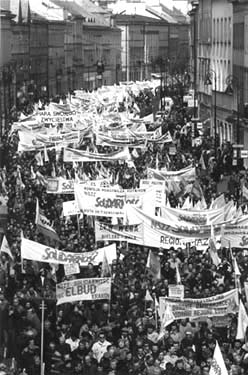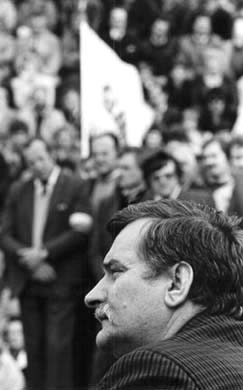- Contemporary
- History
 A Solidarity rally, May 1994. Photo: Krzysztof Miller/Agencja Gazeta. Hoover Institution Archives. A Solidarity rally, May 1994. Photo: Krzysztof Miller/Agencja Gazeta. Hoover Institution Archives. |
The greatest challenge to continued Soviet control of Eastern Europe took place, not surprisingly, in Poland. It was, after all, the largest and ethnically most homogeneous of the Soviet-dominated East European states. Its modern history has been defined largely in terms of opposition to Russian domination. Its Roman Catholic religion, which sets Poland apart from its immediate neighbors and traditional enemies, served to reinforce the sense of nationalism and imbue it with a doctrinal content directly at variance with communism. Almost everything in Polish society and in Polish history conspired against a communist system im- posed on Warsaw from Moscow.
The word conspired is not a mere literary flourish. It describes accurately the Polish posture toward the prevailing communist system in Poland and toward the unequal relationship im-posed by Russia. The 125-year-long subjugation of Poland by its neighbors deeply ingrained the tradition of conspiratorial resistance into the national psyche. To resist repeated partitions and preserve their national identity, the Poles had to practice an internalized national life, quietly conspiring among themselves to evade the often brutal attempts to stamp out all signs of national consciousness. The Russians’ severe repressions during the nineteenth century conditioned the Poles for a more sustained resistance in the twentieth century—to a doctrine not only alien to their traditions and religion but forcibly grafted on their society by those very same Russians.
The enduring strength of the national sentiment enabled Poland to preserve some important islands of national autonomy and authenticity throughout the Stalinist era. The Roman Catholic Church was the most important. Some intellectual autonomy was also preserved, though to a much more limited extent. After 1956, the peasantry was freed from oppressive efforts to impose Soviet-style collectivization on Polish agriculture. The scope of political and doctrinal control over the society by the state was thus significantly reduced.
The spontaneous social effort to inculcate the young with the history of the Polish underground resistance during World War II to both the Nazi and the Soviet invaders played an important role as well. The more the communist regime maligned that resistance, the more attractive its traditions and sacrifices became to the younger postwar generation. This helped sustain large pockets of passive and quiet conspiratorial resistance to spiritual communization. That passive resistance kept open the option of reaching out someday for more ambitious societal self-emancipation.
Almost everything in Polish society and in Polish history conspired against a communist system imposed on Warsaw from Moscow.
That day dawned in the 1970s. By then the disenchantment with the existing system had become pervasive. Even the social strata originally sympathetic to some of the communist-sponsored social reforms had come to view both the Soviet Union and the regime in Poland as brakes on social progress. The intellectuals were thoroughly disaffected and totally reoriented toward the West. The ambition of every aspiring scholar was to spend some time in the West, with the Soviet Union viewed as a provincial backwater. American-sponsored cultural and academic exchanges, notably those developed over a number of years by the Ford Foundation, had a major impact, undoing two decades of regime-sponsored efforts to link Polish culture with that of its eastern neighbor. Polish youth had long forgotten its initial (and, in any case, quite partial and brief) infatuation with the notion of building a new society and was acutely aware of and attracted by the West’s new lifestyle, technological progress, and cultural experimentation. The emancipated peasantry was almost totally Catholic and traditional in its outlook.
The biggest change in political attitude occurred in the industrial working class. Although numerically weak in prewar agrarian Poland, it had a rich syndicalist tradition and was generally of a socialist orientation. The Polish Socialist Party (PPS) had been in the forefront of the struggle for Poland’s national rebirth and had played a major role in the World War II underground.
 Lech Walesa at a presidental campaign rally, 1990. Photo: Marek Wojtek Druszcz. Hoover Institution Archives. Lech Walesa at a presidental campaign rally, 1990. Photo: Marek Wojtek Druszcz. Hoover Institution Archives. |
After the war the Communists crushed the party, and its remnants were amalgamated into the new ruling party, totally dominated by Moscow’s Communists. That ruling party then effected the postwar industrialization of the country, creating thereby a new postpeasant first-generation industrial class more susceptible to communist ideological and organizational mobilization. It is noteworthy, for example, that the 1956 workers’ rebellion in Poznan, which precipitated the emergence in Warsaw of a less servile communist regime under Wladyslaw Gomulka, was undertaken by the older, more traditional, and more politically aware workers but with less resonance among the new first-generation industrial proletariat.
These social currents gained a symbolically important spearhead through the appearance of a genuinely charismatic worker-leader, Lech Walesa. His personal history and political maturation were a microcosm of these broader trends. Walesa was born to a peasant family, brought up in a deeply religious environment, and turned into a dockyard worker in Gdansk as a result of Poland’s postwar industrialization. Disaffected by the continued poverty of the urban proletariat, he was converted to anticommunism by the privileges and abuse of power by the self-centered party officialdom and became further politicized by the bloody confrontation between the dockyard workers and the police in the early 1970s. With the assistance of a group of intellectual political activists, Walesa became the leader and the symbol of the movement that galvanized Poland and gained world-wide recognition.
The name of that movement, Solidarnosc, or Solidarity, also took on great symbolic importance. The essence of totalitarian rule is the elimination of any autonomous political life and the automatization of society. The objective is to make certain that every individual is left alone to face the system as a whole, feeling isolated and often adrift in his or her internal but never publicly expressed opposition. Solidarity conveyed the very opposite message. It signaled a new reality of shared consciousness, of collective confidence, and of an alliance between different social strata or classes. It confronted the communist regime on a broad front: ideologically through its reliance on religion and through its emphasis on democracy and intense commitment to patriotism; organizationally through its nationwide structure and through its alliance with the intellectuals, the young, and, especially, the church.
Solidarity also capitalized on the tangible failures of the communist system. The country’s communist leaders, having borrowed during the early 1970s some $30 billion from the West, simply squandered, through ineptitude and corruption, that massive injection of capital that could have revitalized the economy. The resulting economic crisis necessitated the austerity measures that not only sparked worker unrest but also destroyed any lingering social respect for the country’s communist rulers. Communism no longer represented social advancement for any major social class.
The peasants despised the regime because of the bitter encounter with collectivization and hence did not even credit it for the land reform of the mid-1940s. The urban masses suffered acutely under continuing housing shortages, poor services, endless queuing even for the simplest essentials of life, and escalating food costs. Even the educational system—long a point of special pride on the part of the Communists, who liked to contrast it with the situation in prewar Poland—no longer served as a source of social promotion.
The shared consciousness of deprivation and politicization and a sense of wider social solidarity could not be destroyed even by the imposition of martial law in December 1981. By then a new national consciousness had been forged, one that integrated into the outlook of the masses the very traditions and even historical memories that the Soviet-sponsored regime had for thirty years striven to eradicate. The restoration of the authentic national personality became the enduring legacy of the more promising period of Solidarity’s open existence, and it had the effect of transforming Poland’s political landscape.
Solidarity thus precipitated the spiritual self-emancipation of the country, even though the preexisting political framework continued because of martial law. Nonetheless, the political framework, despite formal institutional continuity, was henceforth filled with a different substance. Martial law was able to destroy and suppress the surface organizational aspects of Solidarity, but it could not prevent the emergence of a de facto alternative political elite and the associated rebirth of genuine political life in Poland—even if that new life still operated partially below the official surface.







